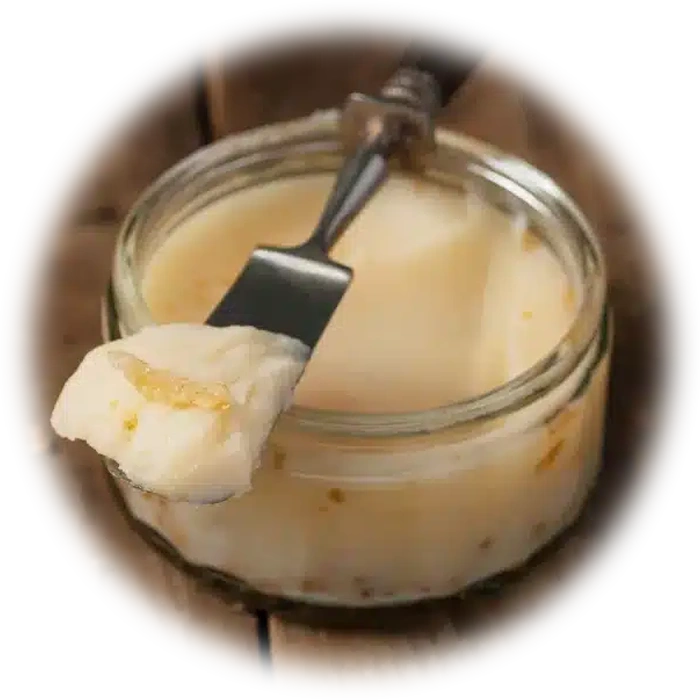
Nutritional properties of Ostrich oil
Energy :
None Kcal / 100g
Category : Oils and Fats
Group : Animal Fats & Oils
Composition And Nutritional Value :Ostrich oil is a naturally derived fat extracted from the fatty tissue of ostriches, particularly from the areas around their abdomen and legs. It is predominantly composed of unsaturated fatty acids, including monounsaturated fats and polyunsaturated fats, which are beneficial for heart health. The oil contains a high level of oleic acid, a type of monounsaturated fat that has been linked to various health benefits, including reducing bad cholesterol levels. Additionally, ostrich oil contains a significant amount of omega-3 fatty acids (such as alpha-linolenic acid), omega-6 fatty acids, and vitamin E, a potent antioxidant. The oil is light in texture and is known for being absorbed quickly by the skin, without leaving a greasy residue.
Health Benefits :
Skin Care: Ostrich oil is highly valued in skincare due to its ability to penetrate deep into the skin and provide moisturization without clogging pores. It is often used in anti-aging products to reduce the appearance of wrinkles and fine lines, and its anti-inflammatory properties help soothe irritated skin. It is also used in the treatment of dry skin, eczema, and sunburns.
Wound Healing: Ostrich oil is believed to accelerate the healing process of wounds and scars, as it contains compounds that promote cell regeneration and reduce scarring. It has been used in some cultures to treat cuts, abrasions, and abrasive skin conditions.
Anti-Inflammatory: The presence of omega-3 fatty acids and other anti-inflammatory compounds in ostrich oil makes it useful for reducing inflammation, which may help with conditions such as arthritis and joint pain.
Hair Care: Due to its rich content of essential fatty acids, ostrich oil is sometimes used as a hair treatment to enhance shine and softness. It also helps to moisturize the scalp, reducing dryness and flakiness.
Cardiovascular Health: The oil’s omega-3 and monounsaturated fats may contribute to heart health by reducing the risk of heart disease, promoting healthy blood circulation, and improving cholesterol levels.
Culinary Uses : While ostrich oil is primarily known for its skin care and medicinal uses, it can also be used for cooking purposes in some cultures. It has a mild flavor, which makes it suitable for roasting, frying, and baking. The high content of monounsaturated fats makes it a stable oil for moderate heat cooking, and it can also be used as a finishing oil for added richness. However, because it is a relatively expensive oil, it is typically used sparingly in food preparations. Some recipes in regions where ostriches are farmed, like parts of Africa and Australia, incorporate ostrich oil into dishes, particularly in stews, soups, or as a base for marinades.
Types :
Pure Ostrich Oil: This is the unrefined form of ostrich oil, which retains the most natural nutrients and is often used in skin care products. It is typically cold-pressed to preserve its beneficial properties.
Refined Ostrich Oil: In some cases, ostrich oil is refined for use in cosmetic and pharmaceutical products. This process may reduce some of the nutritional benefits but makes the oil more stable for longer shelf life.
Ostrich Oil Blends: Some products on the market blend ostrich oil with other beneficial oils, such as jojoba oil, coconut oil, or vitamin E, to create versatile products for specific skin or hair needs.
Shopping And Storage Tips :
Selecting Ostrich Oil: Look for cold-pressed, pure ostrich oil for the highest quality. If purchasing for skincare, check that the oil is free from additives or preservatives.
Storage: Ostrich oil should be stored in a cool, dark place away from heat and light to preserve its freshness and effectiveness. A dark glass bottle is ideal for preventing exposure to light.
Shelf Life: Pure ostrich oil can last up to 1-2 years if stored correctly, but it’s essential to check for any signs of rancidity (such as an unpleasant smell or discoloration) before use.
Usage Tips: For skin care, apply a few drops of ostrich oil to the affected area and massage gently. It is also effective when added to moisturizers or used as a carrier oil in essential oil blends. For hair care, use a small amount to nourish the scalp and condition hair. When cooking, use moderate heat to prevent degrading the oil’s beneficial properties.
Ostrich oil is a unique, versatile product that offers many health benefits, especially for skin and hair care, while also being a viable option for cooking in specific cuisines.

